Structure and Properties Improvement by Recipe Factors of Geopolymer Basalt Fiber Reinforced Concrete for Building Enclosing Structures
Abstract
1. Introduction
2. Materials and Methods
2.1. Materials
- -
- ground granulated blast furnace slag (GGBS) (Severstal, Cherepovets, Russia);
- -
- quartz sand (QS) (Arkhipovskoye v., Russia);
- -
- crushed sandstone (CrS) (Solntsedar-Don, Rostov-on-Don, Russia);
- -
- basalt fiber (BF) (Pascal, Dzerzhinsk, Russia);
- -
- sodium hydroxide (NaOH) (Khimprom, Novocheboksarsk, Russia);
- -
- sodium liquid glass (Na2O(SiO2)n) (Kerami-NSK, Novosibirsk, Russia);
- -
- plasticizer MasterGlenium 115 (P) (BASF Construction Systems, Moscow, Russia).
2.2. Methods
3. Results and Discussion
4. Conclusions
- (1)
- The introduction of basalt fiber into the composition of geoplastic concrete in an amount from 0% to 2%, as well as the use of activators of various compositions, does not have a significant effect on the change in the density of both fresh and hardened concrete. At the same time, the workability of the geopolymer mixture changes. A decrease in cone settlement is observed with increasing concentration of the alkaline activator and the amount of fiber.
- (2)
- Increasing the molarity of NaOH solution from 8 M to 14 M has a positive effect on the strength characteristics and water absorption of geopolymer concrete. As is known, as the concentration of NaOH solution increases, the reactivity also increases. The higher the reactivity, the more active the geopolymerization reaction occurs and the more GGBS particles are activated. The most effective alkaline activator composition for GGBS particles of this granulometry is an activator with a 12 M NaOH solution. The strength of geopolymer concrete increased by 22% in compression and by 30% in bending, and water absorption decreased by 33%.
- (3)
- The introduction of basalt fiber into the composition of geopolymer concrete has a positive effect on its properties. For all applied compositions, the best characteristics were recorded when fibers were introduced in an amount of 1.5%. The increase in strength was: in compression-up to 15%, in bending-up to 48%, water absorption decreased to 20%.
- (4)
- In the course of experimental studies, an effective composition of geopolymer FRC based on ground granulated blast furnace slag with the following recipe was developed: GGBS—408 kg/m3; QS—554 kg/m3; CrS—1094 kg/m3; NaOH (12 M)—40 kg/m3; Na2O(SiO2)n—110 kg/m3; BF—6.1 kg/m3; P—24.5 kg/m3; water—55 kg/m3).
Author Contributions
Funding
Data Availability Statement
Acknowledgments
Conflicts of Interest
References
- Tolstykh, T.; Gamidullaeva, L.; Shmeleva, N.; Gromov, S.; Ermolenko, A. Megapolis as a Symbiosis of Socio-Economic Ecosystems: The Role of Collaboration. J. Open Innov. Technol. Mark. Complex. 2022, 8, 126. [Google Scholar] [CrossRef]
- Baqa, M.F.; Chen, F.; Lu, L.; Qureshi, S.; Tariq, A.; Wang, S.; Jing, L.; Hamza, S.; Li, Q. Monitoring and Modeling the Patterns and Trends of Urban Growth Using Urban Sprawl Matrix and CA-Markov Model: A Case Study of Karachi, Pakistan. Land 2021, 10, 700. [Google Scholar] [CrossRef]
- Gaidzhurov, P.P.; Volodin, V.A. Strength Calculation of the Coupling of the Floor Slab and the Monolithic Reinforced Concrete Frame Column by the Finite Element Method. Adv. Eng. Res. 2022, 22, 306–314. [Google Scholar] [CrossRef]
- McCaffrey, R. Climate change and the cement industry. Glob. Cem. Lime Mag. (Environ. Spec. Issue) 2002, 15, 19. Available online: https://thegreencaiman.files.wordpress.com/2016/03/climate_change_and_the_cement_industry.pdf (accessed on 8 February 2024).
- The State of the Greenhouse Gases in the Atmosphere Based on Global Observations through 2018. WMO Greenh. Gas Bull. 2019, 15, 191536. Available online: https://library.wmo.int/doc_num.php?explnum_id=10100 (accessed on 8 February 2024).
- Khan, K.; Ahmad, W.; Amin, M.N.; Nazar, S. A Scientometric-Analysis-Based Review of the Research Development on Geopolymers. Polymers 2022, 14, 3676. [Google Scholar] [CrossRef] [PubMed]
- Castillo, H.; Collado, H.; Droguett, T.; Vesely, M.; Garrido, P.; Palma, S. State of the art of geopolymers: A review. e-Polymers 2022, 22, 108–124. [Google Scholar] [CrossRef]
- Abdullah, M.; Qazi, A.; Khan, Q.; Kazmi, S.; Munir, M. Experimental and Analytical Investigations on Shear Performance of Ambient-Cured Reinforced Geopolymer Concrete Beams. Buildings 2024, 14, 204. [Google Scholar] [CrossRef]
- Aslan, S.; Erkan, I. The Effects of Fly Ash, Blast Furnace Slag, and Limestone Powder on the Physical and Mechanical Properties of Geopolymer Mortar. Appl. Sci. 2024, 14, 553. [Google Scholar] [CrossRef]
- Volodchenko, A.A. Efficient Silicate Composites of Dense Structure using hollow microspheres and Unconventional Aluminosilicate Raw Materials. Constr. Mater. Prod. 2023, 6, 19–34. [Google Scholar] [CrossRef]
- Adrian Lazarescu, A.; Hegyi, A.; Csapai, A.; Florin, P. The Influence of Different Aggregates on the Physico-Mechanical Performance of Alkali-Activated Geopolymer Composites Produced Using Romanian Fly Ash. Materials 2024, 17, 485. [Google Scholar] [CrossRef] [PubMed]
- Ramesh, V.; Jarghouyeh, E.; Alraeeini, A.; Al-Fakih, A. Optimisation Investigation and Bond-Slip Behaviour of High Strength PVA-Engineered Geopolymer Composite (EGC) Cured in Ambient Temperatures. Buildings 2023, 13, 3020. [Google Scholar] [CrossRef]
- Al Mayyahi, A.; Arunachalam, K.; Zhangabay, N.; Albayati, A. Impact of Low-Reactivity Calcined Clay on the Performance of Fly Ash-Based Geopolymer Mortar. Sustainability 2023, 15, 13556. [Google Scholar] [CrossRef]
- Tiyasangthong, S.; Yoosuk, P.; Krosoongnern, K.; Sakdinakorn, R.; Tabyang, W.; Phojan, W.; Suksiripattanapong, C. Stabilization of Recycled Concrete Aggregate Using High Calcium Fly Ash Geopolymer as Pavement Base Material. Infrastructures 2022, 7, 117. [Google Scholar] [CrossRef]
- Amari, S.; Darestani, M.; Millar, G.J.; Samali, B.; Strounina, E. Engineering and Life Cycle Assessment (LCA) of Sustainable Zeolite-Based Geopolymer Incorporating Blast Furnace Slag. Sustainability 2024, 16, 440. [Google Scholar] [CrossRef]
- Nguyen, Q.D.; Castel, A. Developing Geopolymer Concrete by Using Ferronickel Slag and Ground-Granulated Blast-Furnace Slag. Ceramics 2023, 6, 1861–1878. [Google Scholar] [CrossRef]
- Shilar, F.A.; Ganachari, S.V.; Patil, V.B.; Javed, S.; Khan, T.M.Y.; Baig, R.U. Assessment of Destructive and Nondestructive Analysis for GGBS Based Geopolymer Concrete and Its Statistical Analysis. Polymers 2022, 14, 3132. [Google Scholar] [CrossRef] [PubMed]
- Saini, P.; Singh, P.; Kapoor, K. Strength and Durability Properties of Geopolymer Mortar Made with Concrete Waste Powder. Eng. Proc. 2023, 59, 129. [Google Scholar] [CrossRef]
- Zuaiter, M.; El-Hassan, H.; El-Maaddawy, T.; El-Ariss, B. Properties of Slag-Fly Ash Blended Geopolymer Concrete Reinforced with Hybrid Glass Fibers. Buildings 2022, 12, 1114. [Google Scholar] [CrossRef]
- Anwar, F.H.; El-Hassan, H.; Hamouda, M.; El-Mir, A.; Mohammed, S.; Mo, K.H. Optimization of Pervious Geopolymer Concrete Using TOPSIS-Based Taguchi Method. Sustainability 2022, 14, 8767. [Google Scholar] [CrossRef]
- Lopes, A.; Lopes, S.; Pinto, I. Influence of Curing Temperature on the Strength of a Metakaolin-Based Geopolymer. Materials 2023, 16, 7460. [Google Scholar] [CrossRef] [PubMed]
- Abiodun, Y.O.; Olanrewaju, O.A.; Gbenebor, O.P.; Ochulor, E.F.; Obasa, D.V.; Adeosun, S.O. Cutting Cement Industry CO2 Emissions through Metakaolin Use in Construction. Atmosphere 2022, 13, 1494. [Google Scholar] [CrossRef]
- Arunachelam, N.; Maheswaran, J.; Chellapandian, M.; Murali, G.; Vatin, N.I. Development of High-Strength Geopolymer Concrete Incorporating High-Volume Copper Slag and Micro Silica. Sustainability 2022, 14, 7601. [Google Scholar] [CrossRef]
- Migunthanna, J.; Rajeev, P.; Sanjayan, J. Waste Clay Bricks as a Geopolymer Binder for Pavement Construction. Sustainability 2022, 14, 6456. [Google Scholar] [CrossRef]
- Meskhi, B.; Beskopylny, A.N.; Stel’makh, S.A.; Shcherban’, E.M.; Mailyan, L.R.; Shilov, A.A.; El’shaeva, D.; Shilova, K.; Karalar, M.; Aksoylu, C.; et al. Analytical Review of Geopolymer Concrete: Retrospective and Current Issues. Materials 2023, 16, 3792. [Google Scholar] [CrossRef] [PubMed]
- Kabirova, A.I.; Ibragimov, R.A.; Genç, B.; Korolev, E.V.; Kiyamov, I.K.; Kiyamova, L.I. Research trends in the mechanoactivation of clay minerals used in obtaining geopolymers. Constr. Mater. Prod. 2023, 6, 3. [Google Scholar] [CrossRef]
- Beskopylny, A.N.; Stel’makh, S.A.; Shcherban’, E.M.; Mailyan, L.R.; Meskhi, B.; El’shaeva, D.; Varavka, V. Developing Environmentally Sustainable and Cost-Effective Geopolymer Concrete with Improved Characteristics. Sustainability 2021, 13, 13607. [Google Scholar] [CrossRef]
- Khattab, S.A.; Elshikh, M.M.Y.; Elemam, W.E.; Elshami, A.A.; Youssf, O. Effect of Magnetized Water-Based Alkaline Activator on Geopolymer Concrete Mechanical Performance and Durability. Sustainability 2023, 15, 16315. [Google Scholar] [CrossRef]
- Rehman, S.K.U.; Imtiaz, L.; Aslam, F.; Khan, M.K.; Haseeb, M.; Javed, M.F.; Alyousef, R.; Alabduljabbar, H. Experimental Investigation of NaOH and KOH Mixture in SCBA-Based Geopolymer Cement Composite. Materials 2020, 13, 3437. [Google Scholar] [CrossRef]
- Shcherban’, E.M.; Stel’makh, S.A.; Beskopylny, A.; Mailyan, L.; Meskhi, B. Increasing the Corrosion Resistance and Durability of Geopolymer Concrete Structures of Agricultural Buildings Operating in Specific Conditions of Aggressive Environments of Livestock Buildings. Appl. Sci. 2022, 12, 1655. [Google Scholar] [CrossRef]
- Dvorkin, L.; Konkol, J.; Marchuk, V.; Huts, A. Efficient, Fine-Grained Fly Ash Concrete Based on Metal and Basalt Fibers. Materials 2023, 16, 3969. [Google Scholar] [CrossRef] [PubMed]
- Wang, T.; Fan, X.; Gao, C.; Qu, C.; Liu, J.; Yu, G. The Influence of Fiber on the Mechanical Properties of Geopolymer Concrete: A Review. Polymers 2023, 15, 827. [Google Scholar] [CrossRef] [PubMed]
- Beskopylny, A.N.; Stel’makh, S.A.; Shcherban’, E.M.; Mailyan, L.R.; Meskhi, B.; Beskopylny, N.; El’shaeva, D. Influence of the Chemical Activation of Aggregates on the Properties of Lightweight Vibro-Centrifuged FRC. J. Compos. Sci. 2022, 6, 273. [Google Scholar] [CrossRef]
- Klyuev, A.V.; Kashapov, N.F.; Klyuev, S.V.; Lesovik, R.V.; Ageeva, M.S.; Fomina, E.V.; Ayubov, N.A. Development of alkali-activated binders based on technogenic fibrous materials. Constr. Mater. Prod. 2023, 6, 60–73. [Google Scholar] [CrossRef]
- Stel’makh, S.A.; Shcherban’, E.M.; Beskopylny, A.; Mailyan, L.R.; Meskhi, B.; Dotsenko, N. Enchainment of the Coefficient of Structural Quality of Elements in Compression and Bending by Combined Reinforcement of Concrete with Polymer Composite Bars and Dispersed Fiber. Polymers 2021, 13, 4347. [Google Scholar] [CrossRef] [PubMed]
- Xu, L.; Liu, Q.; Ding, X.; Sun, S.; Sun, S. Mechanical Properties of Fiber-Reinforced Permeable Geopolymer Concrete. Materials 2023, 16, 6030. [Google Scholar] [CrossRef]
- Shaikh, F.; Patel, A. Flexural Behavior of Hybrid PVA Fiber and AR-Glass Textile Reinforced Geopolymer Composites. Fibers 2018, 6, 2. [Google Scholar] [CrossRef]
- Prasad, B.; Anand, N.; Kanagaraj, B.; Kiran, T.; Lubloy, E.; Naser, M.; Arumairaj, P.; Andrushia, D. Investigation on residual bond strength and microstructure characteristics of fiber-reinforced geopolymer concrete at elevated temperature. Case Stud. Constr. Mater. 2023, 19, e02526. [Google Scholar] [CrossRef]
- Yang, Z.; Lu, F.; Zhan, X.; Zhu, H.; Zhang, B.; Chen, Z.; Zhang, H. Mechanical properties and mesoscopic damage characteristics of basalt fibre-reinforced seawater sea-sand slag-based geopolymer concrete. J. Build. Eng. 2024, 84, 108688. [Google Scholar] [CrossRef]
- Wang, Z.; Bai, E.; Ren, B.; Lv, Y. Effects of temperature and basalt fiber on the mechanical properties of geopolymer concrete under impact loads of different high strain rates. J. Build. Eng. 2023, 72, 106605. [Google Scholar] [CrossRef]
- Sadrmomtazi, A.; Rad, S. Investigating the fracture parameters of lightweight geopolymer concrete reinforced with steel and polypropylene fibers. Theor. Appl. Fract. Mech. 2024, 129, 104223. [Google Scholar] [CrossRef]
- Lv, C.; Shen, H.; Liu, J.; Wu, D.; Qu, E.; Liu, S. Properties of 3D Printing Fiber-Reinforced Geopolymers Based on Interlayer Bonding and Anisotropy. Materials 2022, 15, 8032. [Google Scholar] [CrossRef] [PubMed]
- Dhasmana, A.; Singh, S. Long-term mechanical characteristics of fibre reinforced metakaolin-based geopolymer concrete: A review. Mater. Today Proc. 2023, 93, 106–119. [Google Scholar] [CrossRef]
- Zhong, H.; Zhang, M. Engineered geopolymer composites: A state-of-the-art review. Cem. Concr. Compos. 2023, 135, 104850. [Google Scholar] [CrossRef]
- Zhang, X.; Bai, C.; Qiao, Y.; Wang, X.; Jia, D.; Li, H.; Colombo, P. Porous geopolymer composites: A review. Compos. A Appl. Sci. Manuf. 2021, 150, 106629. [Google Scholar] [CrossRef]
- Shaikh, F.U.A. Review of mechanical properties of short fibre reinforced geopolymer composites. Constr. Build. Mater. 2013, 43, 37–49. [Google Scholar] [CrossRef]
- Farhan, K.Z.; Johari, M.A.M.; Demirboğa, R. Impact of fiber reinforcements on properties of geopolymer composites: A review. J. Build. Eng. 2021, 44, 102628. [Google Scholar] [CrossRef]
- Abbas, A.-G.N.; Aziz, F.N.A.A.; Abdan, K.; Nasir, N.A.M.; Huseien, G.F. A state-of-the-art review on fibre-reinforced geopolymer composites. Constr. Build. Mater. 2022, 330, 127187. [Google Scholar] [CrossRef]
- GOST R 57809-2017/EN 12350-2:2009; Testing Fresh Concrete. Part 2. Slump Test. Standardinform: Moscow, Russia, 2019. Available online: https://docs.cntd.ru/document/1200157288 (accessed on 8 February 2024).
- GOST R 57813-2017/EN 12350-6:2009; Testing Fresh Concrete. Part 6. Density. Standardinform: Moscow, Russia, 2019. Available online: https://docs.cntd.ru/document/1200157335 (accessed on 8 February 2024).
- EN 12390-7:2019; Testing Hardened Concrete—Part 7: Density of Hardened Concrete. iTeh Standards: Etobicoke, ON, Canada, 2019. Available online: https://standards.iteh.ai/catalog/standards/cen/811a0cf3-55e3-495a-b06e-5c302d5f2806/en-12390-7-2019 (accessed on 8 February 2024).
- EN 12390-1:2021; Testing Hardened Concrete—Part 1: Shape, Dimensions and Other Requirements of Specimens and Moulds. iTeh Standards: Etobicoke, ON, Canada, 2021. Available online: https://standards.iteh.ai/catalog/standards/cen/d1c9ccee-2e5a-425e-a964-961da95d2f99/en-12390-1-2021 (accessed on 8 February 2024).
- EN 12390-2:2019; Testing Hardened Concrete—Part 2: Making and Curing Specimens for Strength Tests. iTeh Standards: Etobicoke, ON, Canada, 2019. Available online: https://standards.iteh.ai/catalog/standards/cen/ae7e6a86-1cbc-455e-8b2a-8964be9087f9/en-12390-2-2019 (accessed on 8 February 2024).
- EN 12390-3:2019; Testing Hardened Concrete—Part 3: Compressive Strength of Test Specimens. iTeh Standards: Etobicoke, ON, Canada, 2019. Available online: https://standards.iteh.ai/catalog/standards/cen/7eb738ef-44af-436c-ab8e-e6561571302c/en-12390-3-2019 (accessed on 8 February 2024).
- EN 12390-4:2019; Testing Hardened Concrete—Part 4: Compressive Strength—Specification for Testing Machines. iTeh Standards: Etobicoke, ON, Canada, 2019. Available online: https://standards.iteh.ai/catalog/standards/cen/10b1c613-819b-42d7-8f94-480cd37a666a/en-12390-4-2019 (accessed on 8 February 2024).
- Ismayilova, J.J. Analysis of Stress-Strain State of a Cylinder with Variable Elasticity Moduli Based on Three-Dimensional Equations of Elasticity Theory. Adv. Eng. Res. 2023, 23, 113–120. [Google Scholar] [CrossRef]
- EN 12390-5:2019; Testing Hardened Concrete—Part 5: Flexural Strength of Test Specimens. iTeh Standards: Etobicoke, ON, Canada, 2019. Available online: https://standards.iteh.ai/catalog/standards/cen/5653c2c7-55a9-4bcb-8e13-5b1dfb0e3baf/en-12390-5-2019 (accessed on 8 February 2024).
- GOST 12730.3-2020; Concretes. Method of Determination of Water Absorption. Gost Standard: Moscow, Russia, 2020. Available online: https://docs.cntd.ru/document/1200177301 (accessed on 8 February 2024).
- BS 1881-122:2011+A1:2020; Testing Concrete Method for Determination of Water Absorption. European Standards: Plzen, Czech Republic, 2020. Available online: https://www.en-standard.eu/bs-1881-122-2011-a1-2020-testing-concrete-method-for-determination-of-water-absorption/ (accessed on 22 November 2023).
- Mohamed, O.; Zuaiter, H. Fresh Properties, Strength, and Durability of Fiber-Reinforced Geopolymer and Conventional Concrete: A Review. Polymers 2024, 16, 141. [Google Scholar] [CrossRef]
- Sukontasukkul, P.; Intarabut, D.; Phoo-ngernkham, T.; Suksiripattanapong, C.; Zhang, H.; Chindaprasirt, P. Self-compacting steel fibers reinforced geopolymer: Study on mechanical properties and durability against acid and chloride attacks. Case Stud. Constr. Mater. 2023, 19, e02298. [Google Scholar] [CrossRef]
- Puertas, F.; Martínez-Ramírez, S.; Alonso, S.; Vázquez, T. Alkali-activated fly ash/slag cements: Strength behaviour and hydration products. Cem. Concr. Res. 2000, 30, 1625–1632. [Google Scholar] [CrossRef]
- Prasad, B.; Anand, N.; Arumairaj, P.; Francis, A.; Aaron, S.; Gandla, S.; Abhilash, P. Influence of engineering fibers on fresh and mechanical properties of geopolymer concrete. Mater. Today Proc. 2023, in press. [Google Scholar] [CrossRef]
- Aisheh, Y.; Atrush, D.; Akeed, M.; Qaidi, S.; Tayeh, B. Influence of polypropylene and steel fibers on the mechanical properties of ultra-high-performance fiber-reinforced geopolymer concrete. Case Stud. Constr. Mater. 2022, 17, e01234. [Google Scholar] [CrossRef]
- Reddy, R. Influence of steel and PP fibers on mechanical and microstructural properties of fly ash-GGBFS based geopolymer composites. Ceram. Int. 2022, 48, 6808–6818. [Google Scholar] [CrossRef]
- Heweidak, M.; Kafle, B.; Al-Ameri, R. Influence of Hybrid Basalt Fibres’ Length on Fresh and Mechanical Properties of Self-Compacted Ambient-Cured Geopolymer Concrete. J. Compos. Sci. 2022, 6, 292. [Google Scholar] [CrossRef]
- Annadurai, S.; Baskar, P.; Elango, K. Geopolymer concrete reinforced with basalt fibres: An experimental investigation. Mater. Today Proc. 2023, in press. [Google Scholar] [CrossRef]
- Şahin, F.; Uysal, M.; Canpolat, O.; Aygörmez, Y.; Cosgun, T.; Dehghanpour, H. Effect of basalt fiber on metakaolin-based geopolymer mortars containing rilem, basalt and recycled waste concrete aggregates. Constr. Build. Mater. 2021, 301, 124113. [Google Scholar] [CrossRef]
- Ziada, M.; Erdem, S.; Yosra Tammam, Y.; Serenay Kara, S.; Lezcano, R. The Effect of Basalt Fiber on Mechanical, Microstructural, and High-Temperature Properties of Fly Ash-Based and Basalt Powder Waste-Filled Sustainable Geopolymer Mortar. Sustainability 2021, 13, 12610. [Google Scholar] [CrossRef]
- Singh, A.; Bhadauria, S.S.; Thakare, A.A.; Kumar, A.; Mudgal, M.; Chaudhary, S. Durability assessment of mechanochemically activated geopolymer concrete with a low molarity alkali solution. Case Stud. Constr. Mater. 2024, 20, e02715. [Google Scholar] [CrossRef]
- Ranjbar, N.; Zhang, M. Fiber-reinforced geopolymer composites: A review. Cem. Concr. Compos. 2000, 107, 103498. [Google Scholar] [CrossRef]
- Heweidak, M.; Kafle, B.; Al-Ameri, R. Influence of Discrete Basalt Fibres on Shrinkage Cracking of Self-Compacting Ambient-Cured Geopolymer Concrete. J. Compos. Sci. 2023, 7, 202. [Google Scholar] [CrossRef]
- Shcherban’, E.; Beskopylny, A.; Meskhi, B.; Stel’makh, S.; Mailyan, L.; Meskhi, B.; Shilov, A.; Pimenova, E.; El’shaeva, D. Combined Effect of Ceramic Waste Powder Additives and PVA on the Structure and Properties of Geopolymer Concrete Used for Finishing Facades of Buildings. Materials 2023, 16, 3259. [Google Scholar] [CrossRef] [PubMed]
- Beskopylny, A.; Shcherban’, E.; Meskhi, B.; Stel’makh, S.; Mailyan, L.; Meskhi, B.; El’shaeva, D. The Influence of Composition and Recipe Dosage on the Strength Characteristics of New Geopolymer Concrete with the Use of Stone Flour. Appl. Sci. 2022, 12, 613. [Google Scholar] [CrossRef]
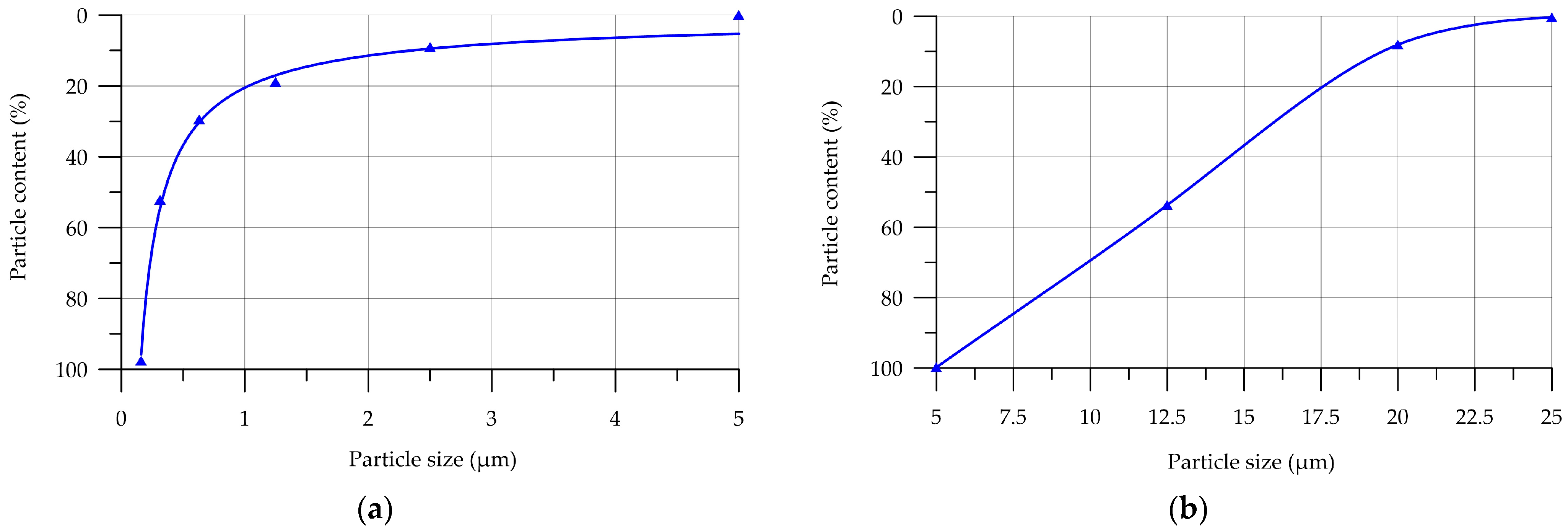
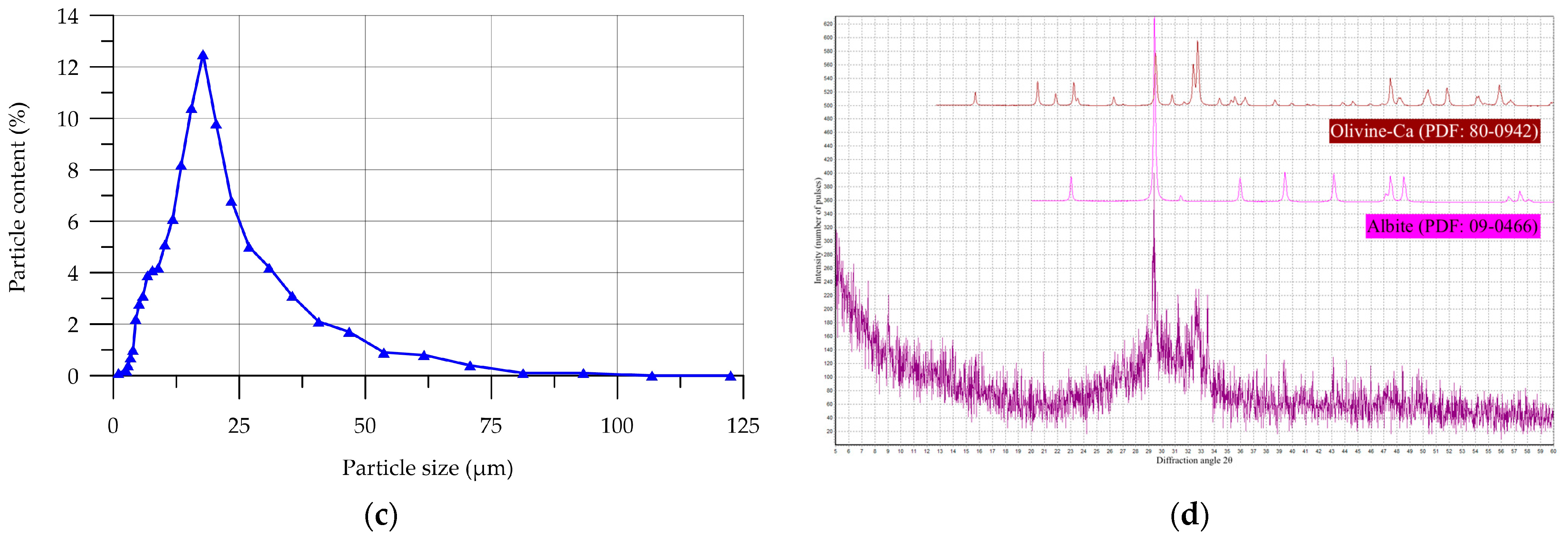
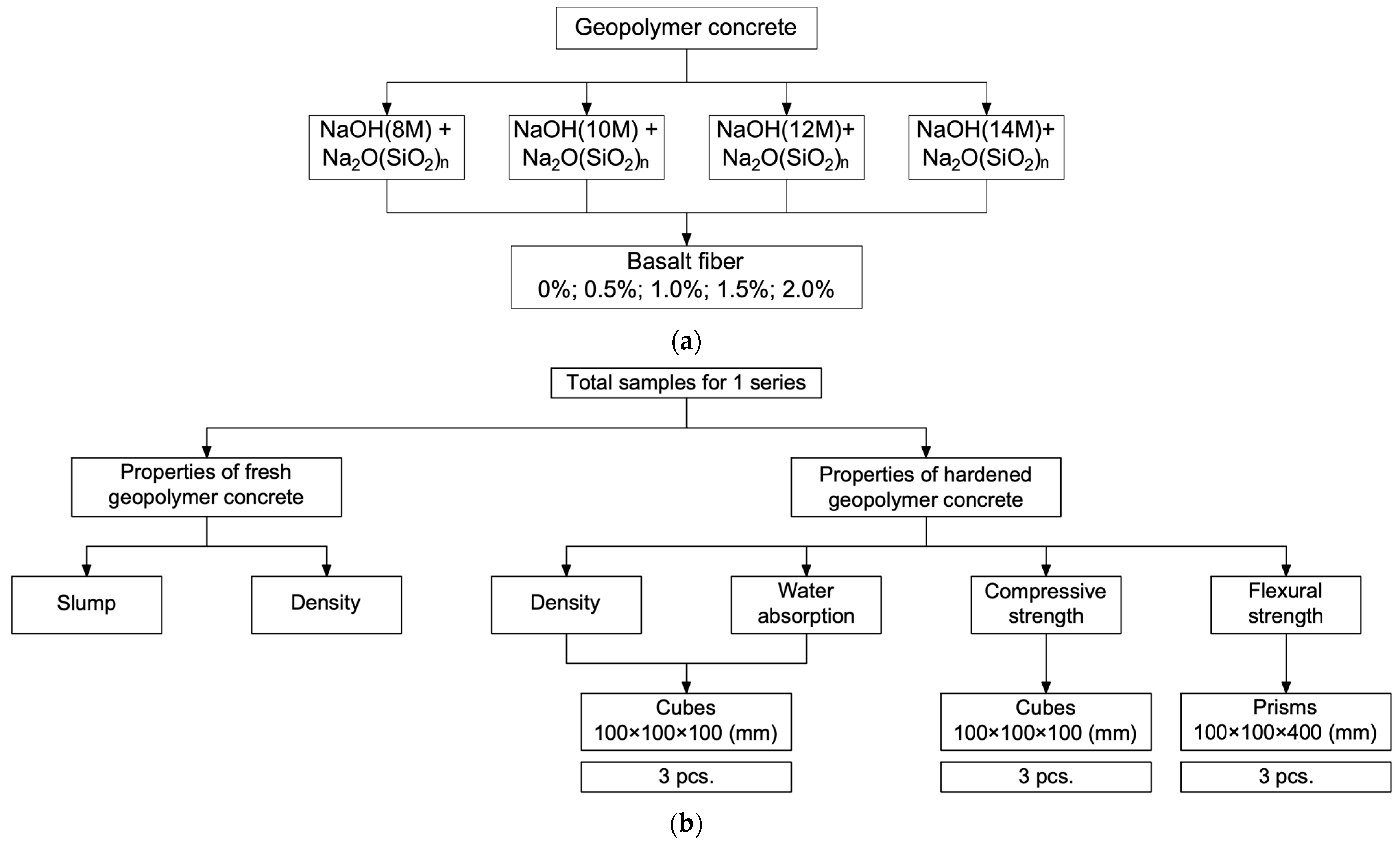


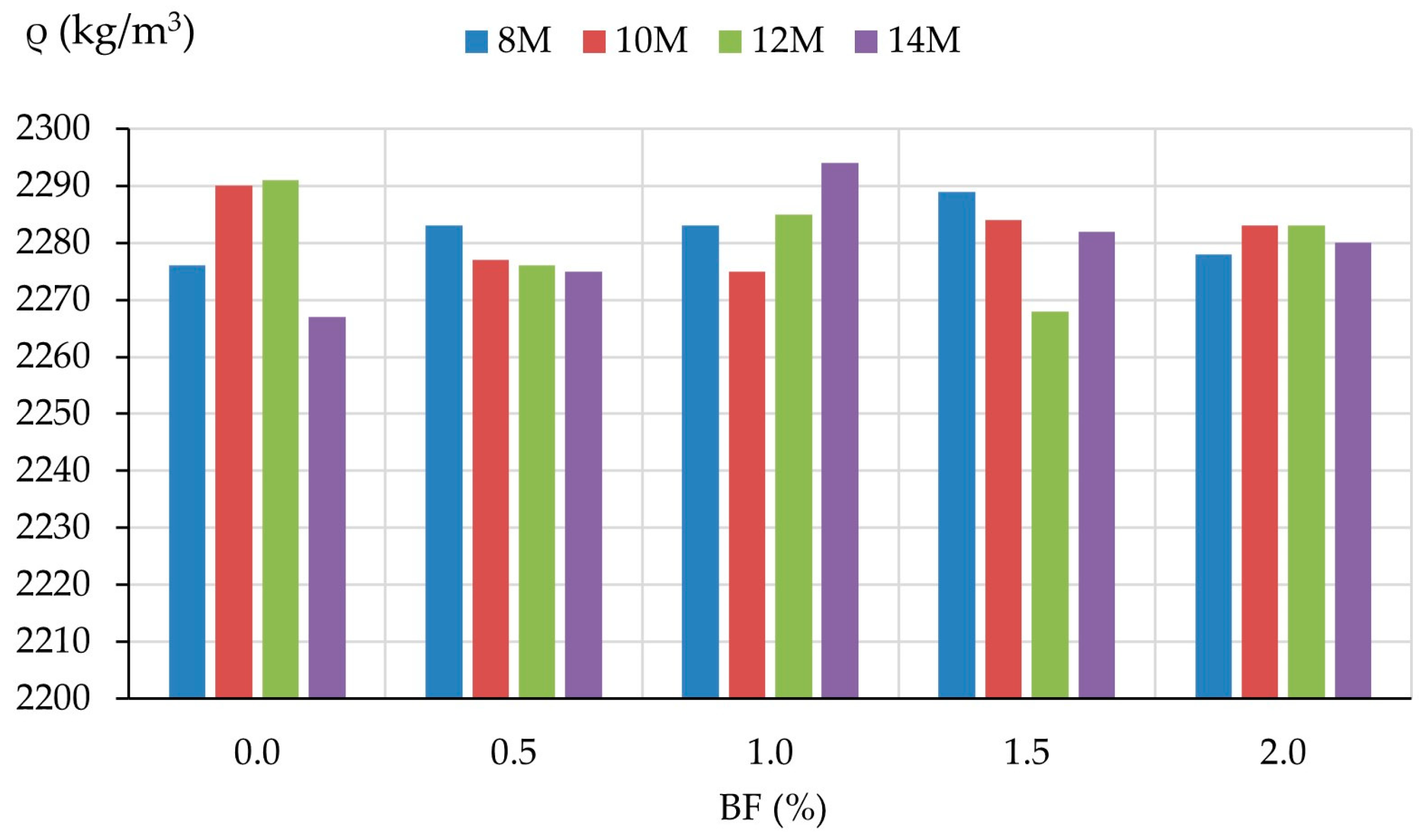
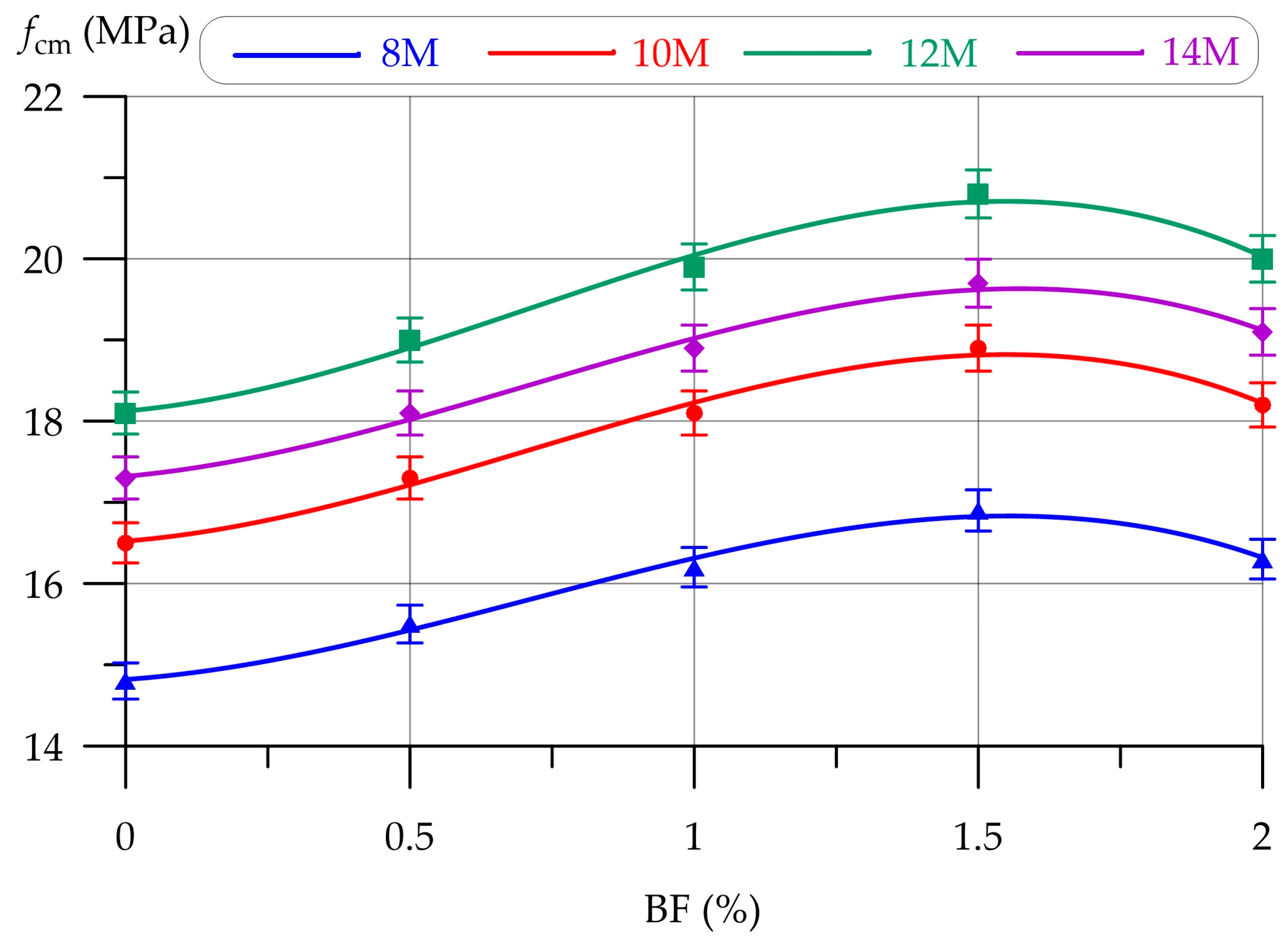
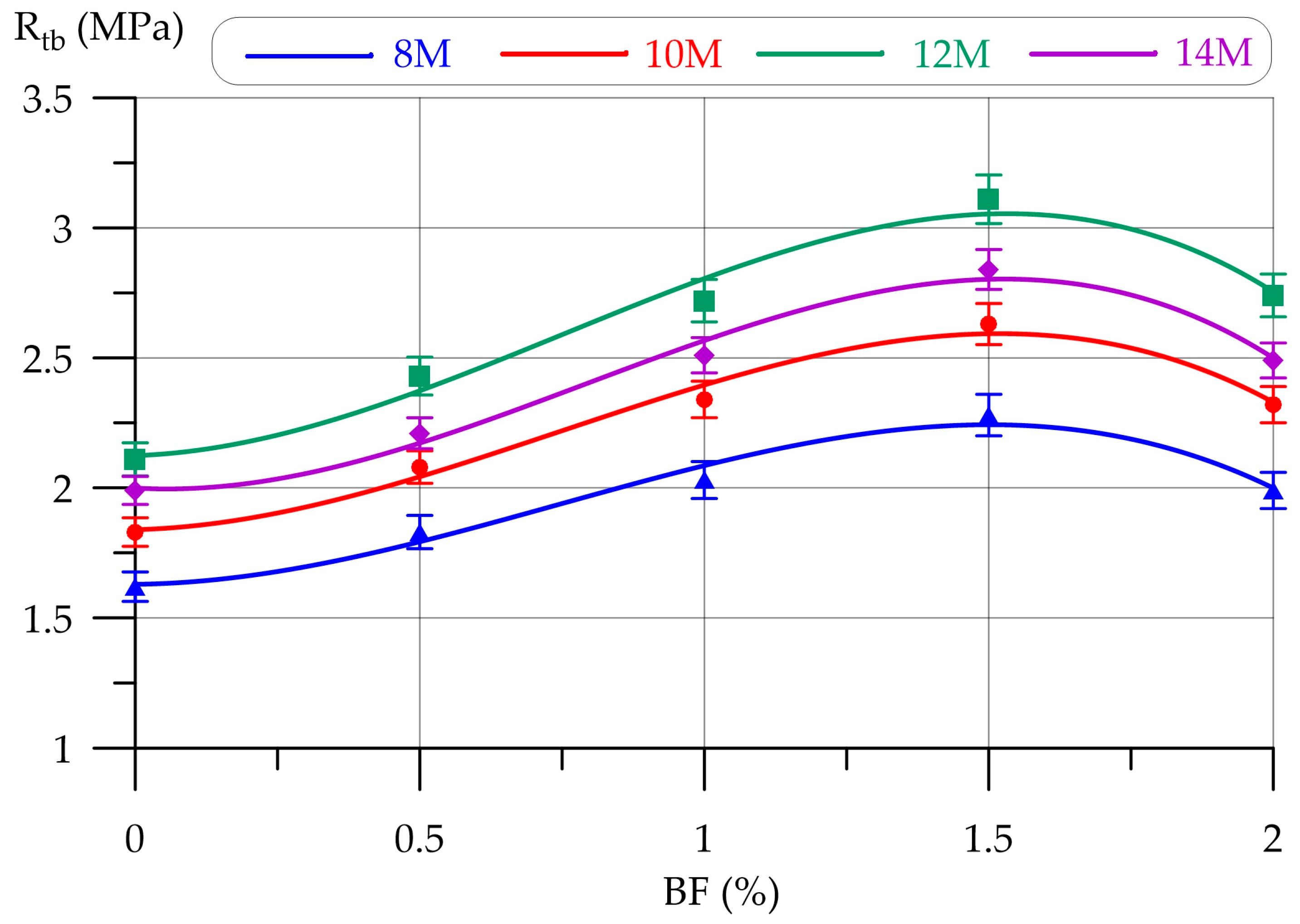
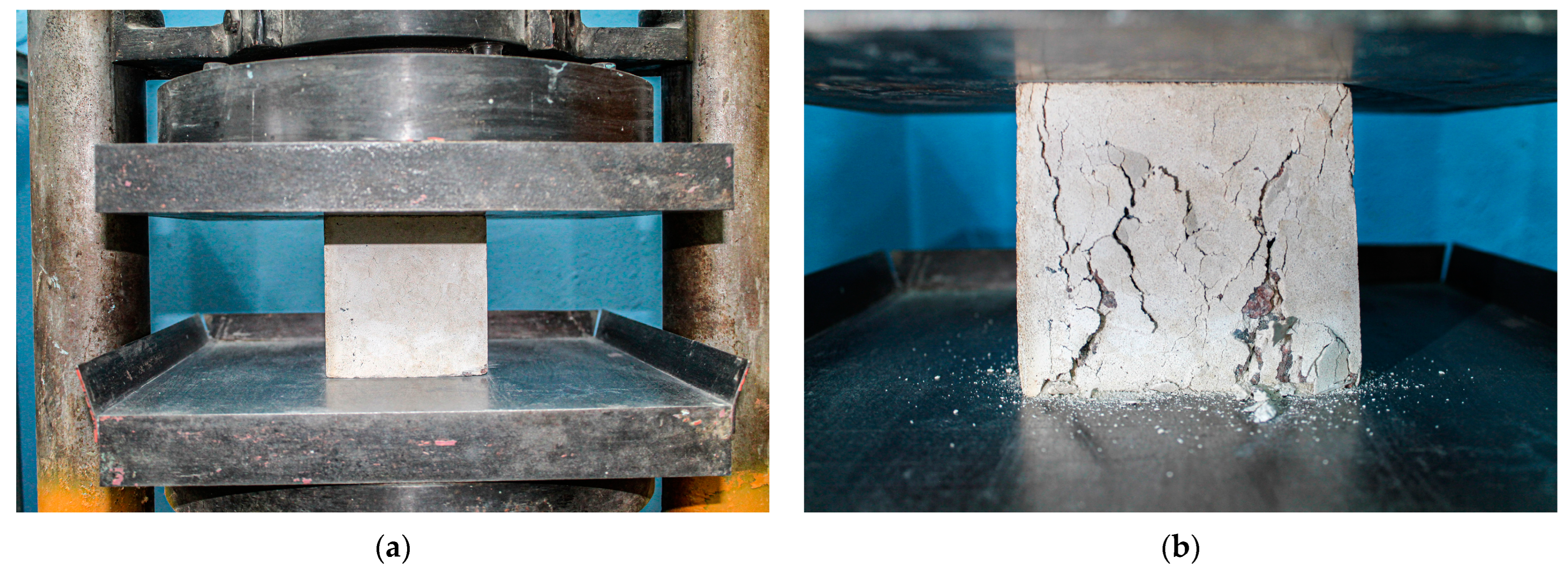
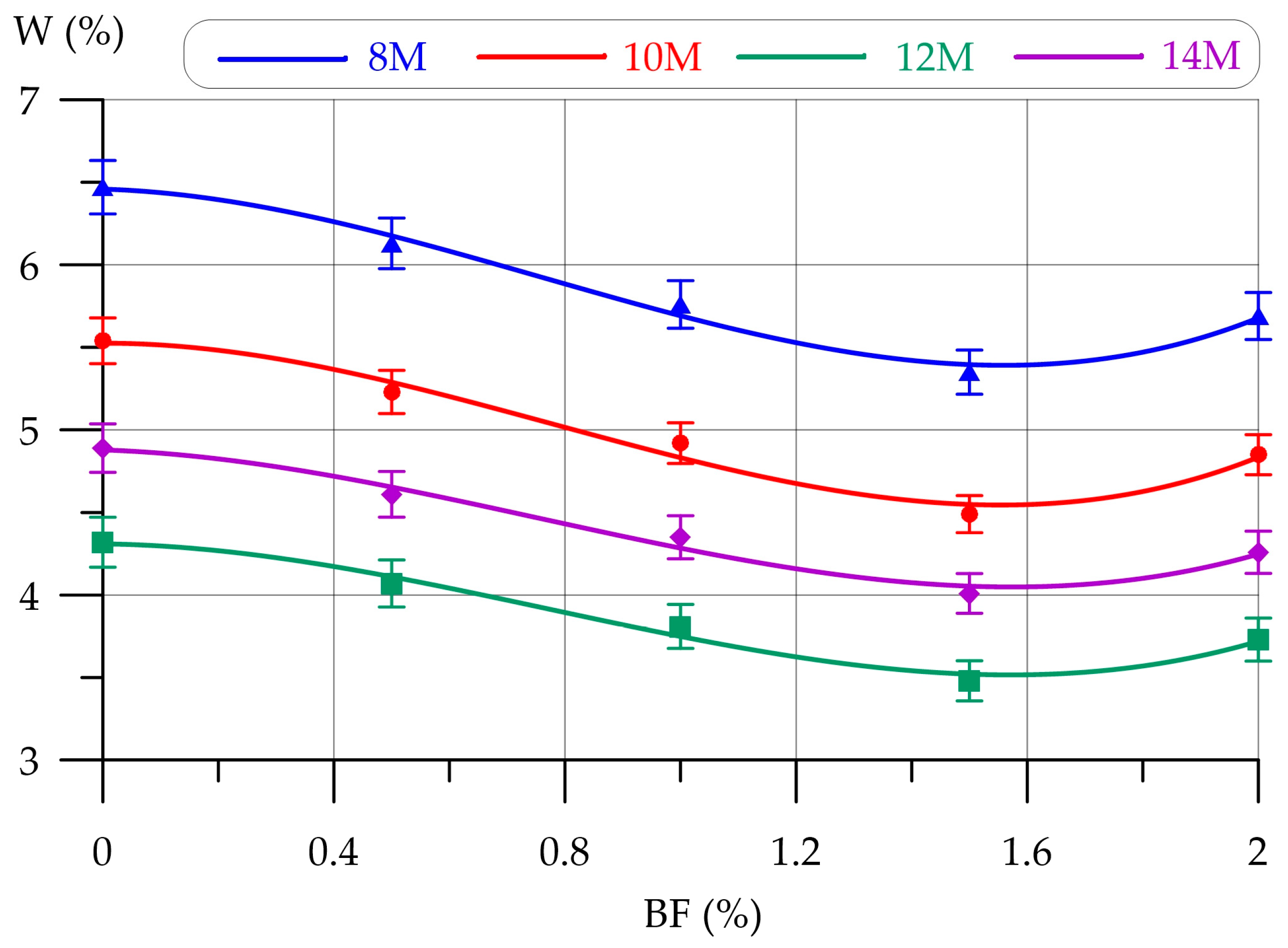

| Name of Raw Material Component | Indicator | Actual Value (Provided by the Manufacturer) |
|---|---|---|
| GGBS | Loss on ignition, 1000 °C (%) | 11.38 |
| Silicon oxide SiO2 (%) | 32.15 | |
| Aluminum oxide Al2O3 (%) | 5.92 | |
| Iron oxide Fe2O3 (%) | 0.73 | |
| Calcium oxide CaO (%) | 40.56 | |
| Magnesium oxide MgO (%) | 5.83 | |
| Titanium oxide TiO2 (%) | 0.28 | |
| Phosphorus oxide P2O5 (%) | 0.04 | |
| Sulfur oxide total. SO3 (%) | 3.11 | |
| Density (kg/m3) | 911 | |
| QS | Bulk density (kg/m3) | 1415 |
| Apparent density (kg/m3) | 2579 | |
| The content of dust and clay particles (%) | 0.05 | |
| Content of clay in lumps (%) | 0.08 | |
| Organic and contaminant content (%) | No | |
| Fineness modulus | 2.07 | |
| CrS | Bulk density (kg/m3) | 1438 |
| Apparent density (kg/m3) | 2665 | |
| Resistance to fragmentation (wt %) | 11.1 | |
| The content of lamellar and acicular grains (wt %) | 8.0 | |
| BF | Fiber length (mm) | From 12 to 15 |
| Density(g/cm3) | 2.6 | |
| Modulus of elasticity (GPa) | 76 | |
| NaOH | Mass fraction of sodium hydroxide (%) | 99.6 |
| Density (kg/m3) | 2130 | |
| (Na2O(SiO2)n) | Mass fraction of SiO2 (%) | 33.7 |
| Mass fraction of Na2O(%) | 14.8 | |
| Mass fraction of H2O (%) | 51.5 | |
| Density (kg/m3) | 1270 | |
| P | Density (kg/m3) | 1064 |
| pH | 5.04 |
| Mixture Type | GGBS (kg/m3) | QS (kg/m3) | CrS (kg/m3) | NaOH (kg/m)3/Molar Concentration | Na2O(SiO2)n, (kg/m3) | BF (kg/m3) | P (kg/m3) | Water (L/m3) |
|---|---|---|---|---|---|---|---|---|
| 8 M/BF0 | 408 | 554 | 1094 | 40 (8 M) | 110 | 0 | 24.5 | 55 |
| 8 M/BF0.5 | 408 | 554 | 1094 | 40 (8 M) | 110 | 2.0 | 24.5 | 55 |
| 8 M/BF1.0 | 408 | 554 | 1094 | 40 (8 M) | 110 | 4.1 | 24.5 | 55 |
| 8 M/BF1.5 | 408 | 554 | 1094 | 40 (8 M) | 110 | 6.1 | 24.5 | 55 |
| 8 M/BF2.0 | 408 | 554 | 1094 | 40 (8 M) | 110 | 8.2 | 24.5 | 55 |
| 10 M/BF0 | 408 | 554 | 1094 | 40 (10 M) | 110 | 0 | 24.5 | 55 |
| 10 M/BF0.5 | 408 | 554 | 1094 | 40 (10 M) | 110 | 2.0 | 24.5 | 55 |
| 10 M/BF1.0 | 408 | 554 | 1094 | 40 (10 M) | 110 | 4.1 | 24.5 | 55 |
| 10 M/BF1.5 | 408 | 554 | 1094 | 40 (10 M) | 110 | 6.1 | 24.5 | 55 |
| 10 M/BF2.0 | 408 | 554 | 1094 | 40 (10 M) | 110 | 8.2 | 24.5 | 55 |
| 12 M/BF0 | 408 | 554 | 1094 | 40 (12 M) | 110 | 0 | 24.5 | 55 |
| 12 M/BF0.5 | 408 | 554 | 1094 | 40 (12 M) | 110 | 2.0 | 24.5 | 55 |
| 12 M/BF1.0 | 408 | 554 | 1094 | 40 (12 M) | 110 | 4.1 | 24.5 | 55 |
| 12 M/BF1.5 | 408 | 554 | 1094 | 40 (12 M) | 110 | 6.1 | 24.5 | 55 |
| 12 M/BF2.0 | 408 | 554 | 1094 | 40 (12 M) | 110 | 8.2 | 24.5 | 55 |
| 14 M/BF0 | 408 | 554 | 1094 | 40 (14 M) | 110 | 0 | 24.5 | 55 |
| 14 M/BF0.5 | 408 | 554 | 1094 | 40 (14 M) | 110 | 2.0 | 24.5 | 55 |
| 14 M/BF1.0 | 408 | 554 | 1094 | 40 (14 M) | 110 | 4.1 | 24.5 | 55 |
| 14 M/BF1.5 | 408 | 554 | 1094 | 40 (14 M) | 110 | 6.1 | 24.5 | 55 |
| 14 M/BF2.0 | 408 | 554 | 1094 | 40 (14 M) | 110 | 8.2 | 24.5 | 55 |
| BF (%) | ∆fcm (%) | |||
|---|---|---|---|---|
| Molarity of Solution NaOH | ||||
| 8 M | 10 M | 12 M | 14 M | |
| 0 | 0.0 | 0.0 | 0.0 | 0.0 |
| 0.5 | 4.7 | 4.8 | 5.0 | 4.6 |
| 1.0 | 9.5 | 9.7 | 9.9 | 9.2 |
| 1.5 | 14.2 | 14.5 | 14.9 | 13.9 |
| 2.0 | 10.1 | 10.3 | 10.5 | 10.4 |
| BF (%) | ∆Rtb (%) | |||
|---|---|---|---|---|
| Molarity of Solution NaOH | ||||
| 8 M | 10 M | 12 M | 14 M | |
| 0 | 0.0 | 0.0 | 0.0 | 0.0 |
| 0.5 | 13.0 | 13.7 | 15.2 | 10.0 |
| 1.0 | 25.3 | 27.9 | 28.9 | 25.0 |
| 1.5 | 40.7 | 43.7 | 47.4 | 45.0 |
| 2.0 | 22.8 | 26.8 | 29.9 | 25.1 |
| BF (%) | Water Absorption Reduction (∆W), % | |||
|---|---|---|---|---|
| Molarity of Solution NaOH | ||||
| 8 M | 10 M | 12 M | 14 M | |
| 0 | 0.0 | 0.0 | 0.0 | 0.0 |
| 0.5 | 5.26 | 5.60 | 5.79 | 5.73 |
| 1.0 | 10.97 | 11.19 | 11.81 | 11.04 |
| 1.5 | 17.31 | 18.95 | 19.44 | 18.0 |
| 2.0 | 12.06 | 12.45 | 13.66 | 12.90 |
Disclaimer/Publisher’s Note: The statements, opinions and data contained in all publications are solely those of the individual author(s) and contributor(s) and not of MDPI and/or the editor(s). MDPI and/or the editor(s) disclaim responsibility for any injury to people or property resulting from any ideas, methods, instructions or products referred to in the content. |
© 2024 by the authors. Licensee MDPI, Basel, Switzerland. This article is an open access article distributed under the terms and conditions of the Creative Commons Attribution (CC BY) license (https://creativecommons.org/licenses/by/4.0/).
Share and Cite
Zubarev, K.P.; Shcherban’, E.M.; Stel’makh, S.A.; Beskopylny, A.N.; Elshaeva, D.; Chernil’nik, A.; Zakieva, N.I.; Pimenova, E.V.; Shilov, A.A. Structure and Properties Improvement by Recipe Factors of Geopolymer Basalt Fiber Reinforced Concrete for Building Enclosing Structures. Buildings 2024, 14, 743. https://doi.org/10.3390/buildings14030743
Zubarev KP, Shcherban’ EM, Stel’makh SA, Beskopylny AN, Elshaeva D, Chernil’nik A, Zakieva NI, Pimenova EV, Shilov AA. Structure and Properties Improvement by Recipe Factors of Geopolymer Basalt Fiber Reinforced Concrete for Building Enclosing Structures. Buildings. 2024; 14(3):743. https://doi.org/10.3390/buildings14030743
Chicago/Turabian StyleZubarev, Kirill P., Evgenii M. Shcherban’, Sergey A. Stel’makh, Alexey N. Beskopylny, Diana Elshaeva, Andrei Chernil’nik, Nadezhda I. Zakieva, Elena V. Pimenova, and Alexandr A. Shilov. 2024. "Structure and Properties Improvement by Recipe Factors of Geopolymer Basalt Fiber Reinforced Concrete for Building Enclosing Structures" Buildings 14, no. 3: 743. https://doi.org/10.3390/buildings14030743
APA StyleZubarev, K. P., Shcherban’, E. M., Stel’makh, S. A., Beskopylny, A. N., Elshaeva, D., Chernil’nik, A., Zakieva, N. I., Pimenova, E. V., & Shilov, A. A. (2024). Structure and Properties Improvement by Recipe Factors of Geopolymer Basalt Fiber Reinforced Concrete for Building Enclosing Structures. Buildings, 14(3), 743. https://doi.org/10.3390/buildings14030743











